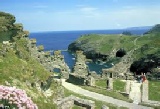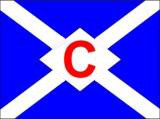|
Commodity |
Quantity |
Commodity |
Quantity |
Commodity |
Quantity |
|
Fresh beef |
10 tons |
Dried Currents |
1300 Lbs |
Pickles |
212 gallons |
|
Salt Beef |
3000 lbs |
Raisins |
1700 lbs |
Flour |
22 tons |
|
Mutton |
12 tons |
Potatoes |
22 tons |
Biscuits |
2 tons |
|
Preserved meat |
3700 lbs |
Pressed vegetables |
3 cwt |
Butter |
4000 lbs |
|
Suet |
1900 lbs |
Preserved carrots |
1 ton |
Oatmeal |
4800 lbs |
|
Pork |
3200 lbs |
Split peas |
1600 lbs |
Cheese |
4000 lbs |
|
Sausages |
1400 lbs |
Dried peas |
1 ton |
Fresh milk |
200 gallons |
|
Bacon |
1½ tons |
Beans |
2800 lbs |
Condensed milk |
5500 tins |
|
Salt fish |
1350 lbs |
Rice |
5700 lbs |
Coffee |
2000 lbs |
|
Finnan haddock |
1 ton |
Pearl barley |
1200 lbs |
Tea |
1200 lbs |
|
Fresh herrings |
5400 lbs |
Semolina |
130 lbs |
Pepper |
130lbs |
|
Smoked cod |
1350 lbs |
Marmalade |
5½ tons |
Sugar |
93 cwt |
|
Canned salmon |
1 ton |
Vinegar |
200 gallons |
Mustard |
300 lbs |
|
Eggs |
22000 |
Apples |
600 gallons |
Golden syrup |
2800 lbs |
|
|
|
Lime juice |
900 quarts |
Curry powder |
170 lbs |
|
Dried figs |
1200 lbs |
Prunes |
1240 lbs |
Jam |
2700 lbs |
|
Hops |
24 lbs |
Malt |
170 lbs |
Salt |
1800 lbs |
|
Day |
Breakfast |
Lunch |
Tea |
Supper |
|
Monday |
Porridge & Golden Syrup. Stewed Steak Bread & Butter, Coffee |
Soup, Roast Beef Boiled Mutton Cabbage, Boiled Potatoes, Compote Of Figs |
Cold Meat Pickles, Jams Tea, Bread & Butter |
Bread & Cheese Biscuits |
|
Tuesday |
Porridge & Golden Syrup Finnan Haddock. Bread & Butter, Coffee |
Soup, Boiled Beef & Vegetables. Roast Mutton, Haricot Beans, Boiled Potatoes, Stewed Apples & Rice |
Cold Meat Pickles, Jam Canned Salmon Tea, Bread & Butter |
Bread & Cheese Biscuits |
|
Wednesday |
Porridge & Golden Syrup Grilled Sausages, Bread & Butter, Coffee |
Soup, Braised Beef & Vegetables. Boiled Mutton, Blue Peas, Boiled Potatoes, Compote Of Prunes. |
Cold Meat Pickles, Jam Tea, Bread & Butter |
Bread & Cheese Biscuits |
|
Thursday |
Porridge & Golden Syrup Scrambled Eggs & Bacon Bread & Butter, Coffee |
Soup, Roast Beef Roast Mutton, Pumpkin, Boiled Potatoes, Plum Pudding. |
Cold Meat Pickles, Canned Herrings Marmalade Tea, Bread & Butter. |
Bread & Cheese Biscuits |
|
Friday |
Porridge & Golden Syrup Ling Fish & Egg Sauce Bread & Butter, Coffee. |
Soup, Boiled Beef & Vegetables. Roast Mutton, Cabbage, Boiled Potatoes, Rice Pudding. |
Coat Meat Pickles, Jam Tea, Bread & Butter |
Bread & Cheese Biscuits |
|
Saturday |
Porridge & Golden Syrup Grilled Steak, Bread & Butter, Coffee. |
Soup, Roast Beef Boiled Mutton Haricot Beans, Boiled Potatoes Compote of Figs |
Cold Meat Pickles, Canned Salmon Marmalade Tea, Bread & Butter. |
Bread & Cheese Biscuits |
|
Sunday |
Porridge & Golden Syrup Buttered Eggs & Bacon Bread & Butter, Coffee. |
Soup, Braised Beef & Vegetables Roast Mutton, Blue Peas, Boiled Potatoes, Plum Pudding. |
Cold Meat Pickles, Jam Canned Herrings Tea, Bread & Butter. |
Bread & Cheese Biscuits |
Regiment |
Sailed |
Arrived |
|
Worcestershire Regiment - 2nd Battalion |
16 December from Southampton |
8 January at Cape Town |
|
Queen’s Royal West Surrey Regiment East Surrey Regiment |
March 1900 from Southampton |
March 1900 at Cape Town |
|
Master |
From |
To |
|
R Rendall |
12/1896 |
8/1897 |
|
R F Harris |
2/1898 |
8/1901 |
|
F P Whitehead |
11/1901 |
2/1904 |
|
T Chope |
5/1904 |
12/1904 |
|
F P Whitehead |
1/1905 |
7/1905 |
|
T Chope |
7/1905 |
2/1908 |
|
G K Gandy |
4/1907 |
7/1907 |
|
W W Verrall |
7/1907 |
11/1907 |
|
G J Gandy |
12/1907 |
6/1908 |
|
W W Verrall |
6/1908 |
5/1911 |
|
D H Hoskins |
6/1911 |
9/1911 |
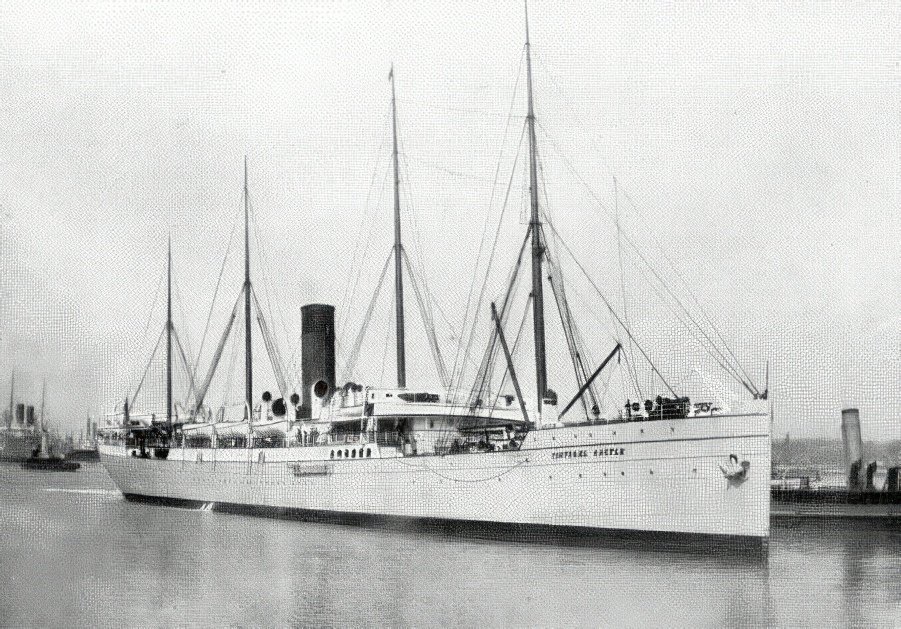
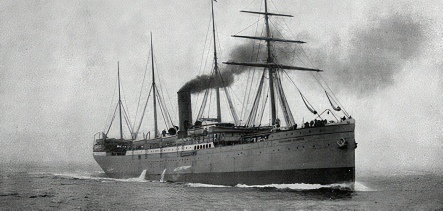
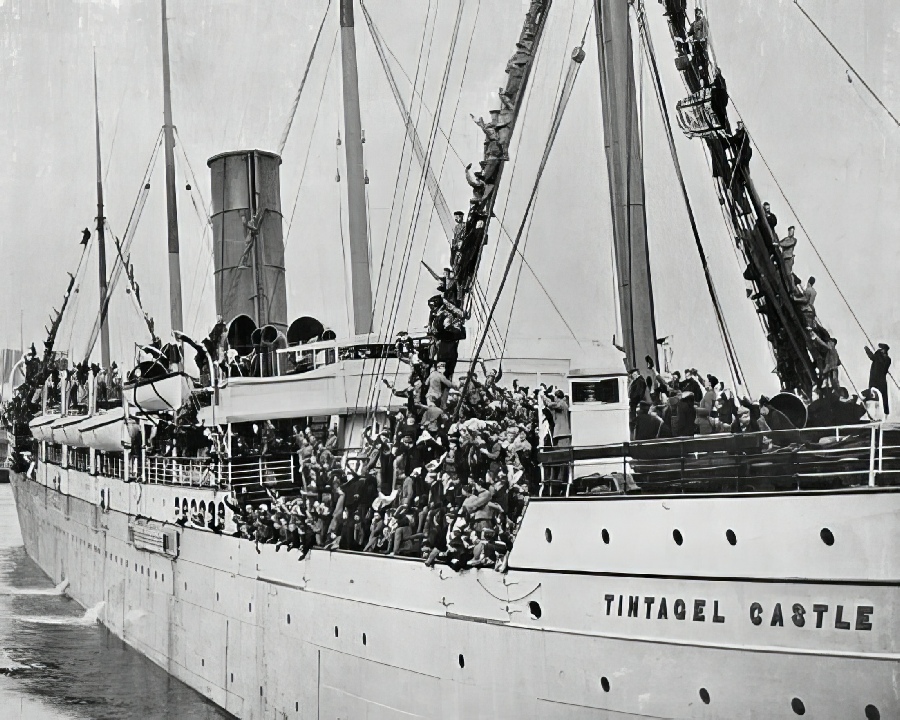
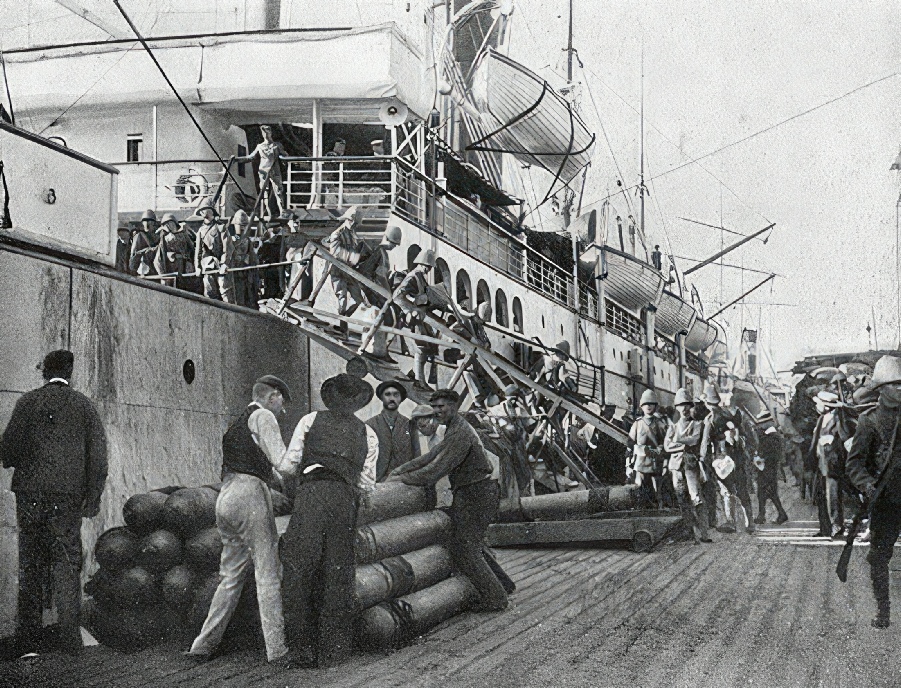
Vessel |
Built |
Tonnage |
Official No |
Ship Builder |
Engine Builder |
Engine Type |
HP |
Screws |
Speed |
|
Tintagel Castle (1) |
1896 |
5531 |
105900 |
Fairfield Govan |
Triple Expansion Steam |
620 NHP |
1 |
15 |
|
